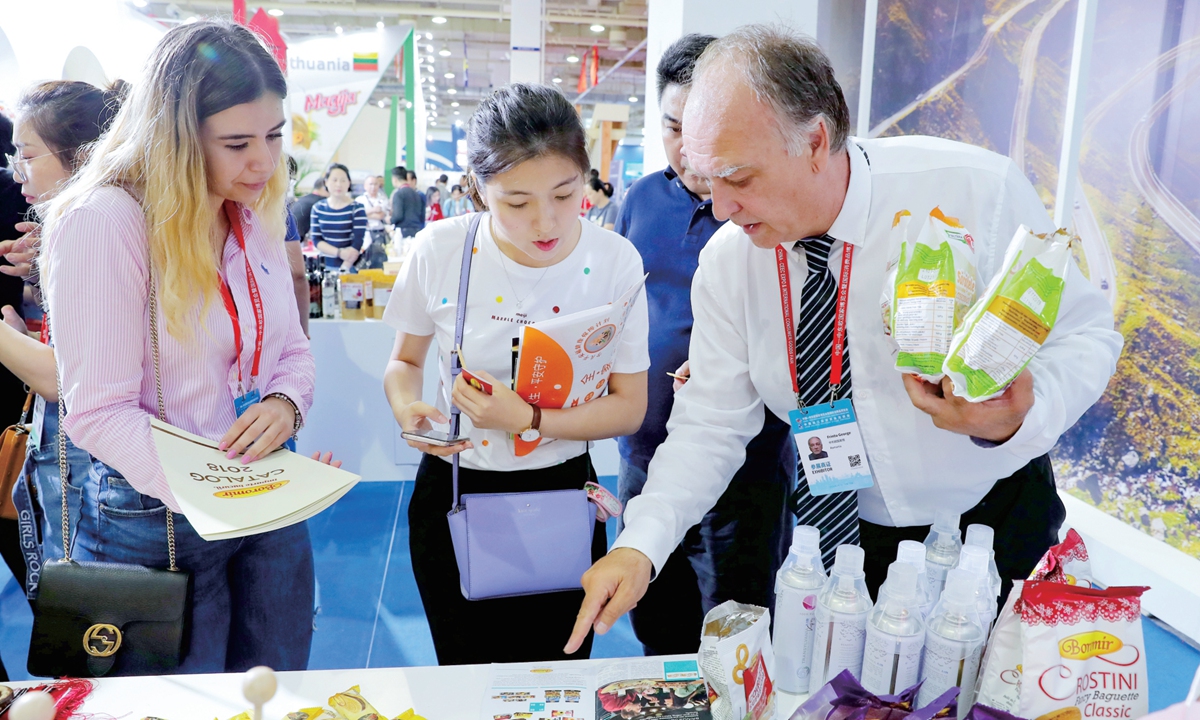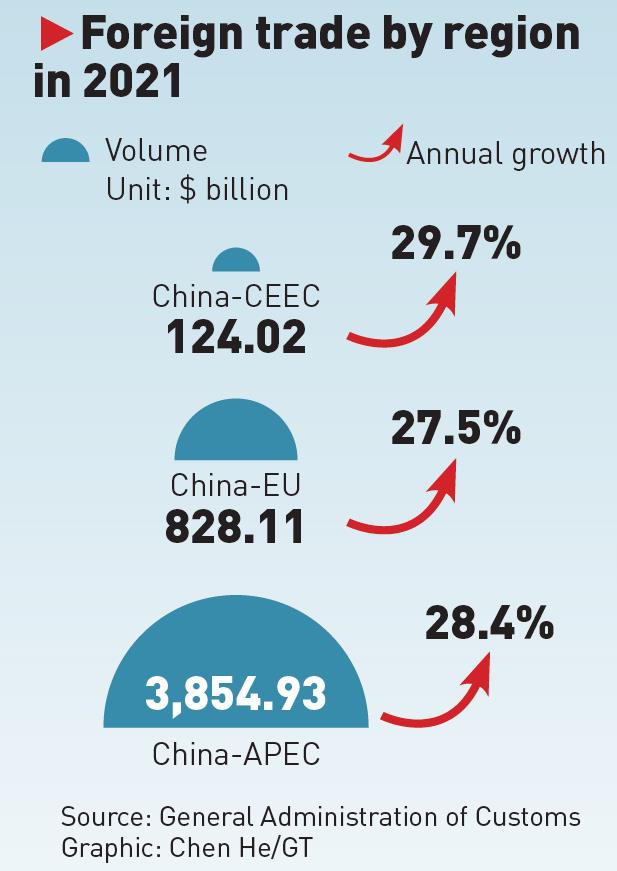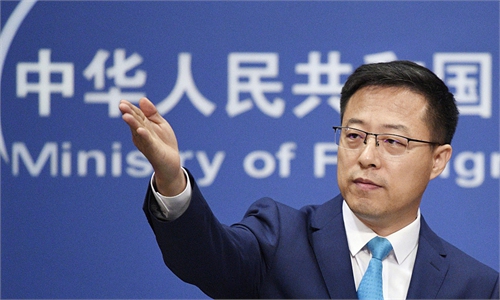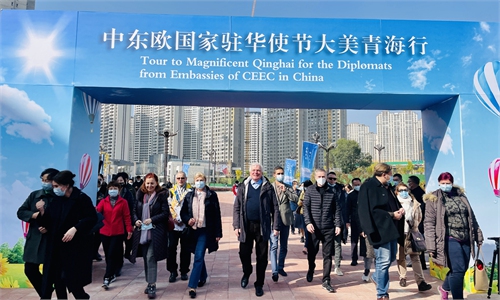China-CEEC Cooperation under the BRI remains a key window for future economic and trade ties despite external disruptions
US dismantling in Baltic region merits attention: experts

View of Tallinn, Estonia Photo: VCG
China's development in partnership with the Central and Eastern European Countries (CEEC) has borne fruitful results since the mechanism was first initiated in 2012 with both economic and trade between China and the regional countries recording historic growth under the cooperative mechanism and China-proposed Belt and Road Initiative (BRI) connecting East and the West, despite the external disruptions linked to multiple factors including the pandemic, trade and political complexity.
Ten years on since the China and CEEC Cooperation was launched, a joint cross-regional platform that was based on the common will of all participants for win-win cooperation and development, has produced solid results.
The platform also dealt with new challenges as Europe has come to a point where the US and its followers intensified its political-driven dominance to regional affairs, posing unprecedented challenges and potential disruption to ordinary economic and trade cooperation between the region and China, their major trading partner, exemplified by the Baltic countries Latvia and Estonia's recent withdrawal from the China-CEEC Cooperation, experts said.
Following in Lithuania's footstep, Latvia and Estonia announced on August 11 their decision not to participate in the China-CEEC Cooperation, or the 16+1 cooperation, a move that experts and business representatives said fits with the US fundamental goal of dismantling the regional cooperative atmosphere and will only serve to shake the confidence among business groups in the region as well as generate uncertainty throughout cross-continental economic and trade development.
The US has certainly played its part in attempting to dismantle the China-CEEC Cooperation over its so-called national security concerns as well as its empty-promise of economic input through a number of infrastructure schemes, all linked to the US' fundamental purpose of confronting China, Cui Hongjian, director of the Department of European Studies at the China Institute of International Studies, told the Global Times on Thursday.
In a separate statement issued by the two Baltic countries addressing their withdrawal from the mechanism, they both expressed their strong willingness to strive for a constructive and pragmatic relation with China both bilaterally, as well as through EU-China cooperation, which experts have said is in contrast with the US and Lithuanian position.
The attitudes of the two countries over the matter are also in stark contrast with the provocative stance of Lithuania when it announced its decision to stop participating in the cooperative mechanism last May while closely following the US in damaging its relations with China, particularly when it comes to its reckless violation of the one-China principle, a basic norm of international relations and a universal consensus held by the international community, experts said.
Concerns over disruption
Experts have noted that regional development needs more collaboration, especially when Europe is the midst of heightened tensions as the Russia-Ukraine conflict continues and the corresponding outcomes ignited by the US' provocative approach to the region.
Through China-CEEC Cooperation, bilateral trade has achieved significant growth. As a direct witness of the change, Xia Xiaolei, Executive Vice Chairman of Latvian Federation of Oversea Chinese Compatriots, told the Global Times that the cooperation not only has lowered the costs and boosted cargo deliveries as well as personnel exchanges, it also diversified the trade goods between the two countries and China.
Xia said that Latvia's withdrawal from China-CEEC Cooperation is "a very irrational and unwise" choice, which could bring about various uncertainties for business and trade in the future terms.
"Latvia's resistance against Russian goods following the EU's call to sanction Russia has already pushed up the domestic living costs and raised concerns over an energy shortage… the country's withdrawal from the cooperative mechanism with China may only add fuel to its already deteriorated economy," Xia said.
While it is still too early to tell the exact possible outcomes, it is almost certain that some local companies in Latvia will have to deal with various inconveniences and difficulties after Latvia's pullout, and some substantive changes are expected to take place in bilateral trade, Xia said.
"As far as businesses are concerned, these changes may produce worsening results, which is also what we do not want to see," Xia said.
While Latvia, Estonia's withdrawal from the multilateral partnership may not produce immediate adverse outcome, the investors' confidence and plan for future cooperation in the Baltic region could be shattered, industry insiders said.
Chinese companies entered CEEC markets relatively late compared with other markets in Europe, and most investments are concentrated on relatively large markets such as Hungary, a business representative of a state-owned infrastructure company told the Global Times on condition of anonymity, noting that the firm, as a result of late market exploration, has only "limited" projects in CEEC.
"China-CEEC Cooperation is a supplement to overall China-Europe economic ties, but certain CEEC have been politicizing normal economic integration under the US pressure, which could impact investors' confidence in those countries," the representative said.
Hao Ning, a manager from Latvia's RILAK Mineral Paints, told the Global Times on Thursday that they will continue to embrace the Chinese market, which is opening up and sharing development opportunities with the world, despite the world complexity.
The painting of Beijing Daxing International Airport, a top infrastructure achievement in China completed last year, was sourced to a lesser-known brand from Latvia, a country not so well-known in China before. This example alone shows China's sincerity in opening up its door and sharing its growth opportunity with the world.
Frankly speaking, this kind of sincerity is rare in today's world, Hao said.
RILAK paints were used for 80 percent of the wall coating at the Beijing Daxing International Airport.
Quitting the platform will definitely mean the loss of certain opportunities, Hao said. "BRI-related benefits and CEEC-themed dividends are now off the table."

Participants at Hall 5 of the first China-CEEC Expo in 2019 Photo: Courtesy of the publicity department of Ningbo
From my experience, these platforms build with real money from Chinese central and local governments and have real value for businesses, offering companies previously inaccessible resources.
Despite geopolitical tension, as a supporter, witness and participant of BRI, I think cooperation which yields benefits to all will prevail over confrontation, Hao said, noting his company is planning to set up production plant and R&D center to expand its footprint in the Chinese market.
Facts speak louder
While the recent moves by the Baltic countries have cast a shadow of concern over industry participants, the solid foundation of the economic and trade ties between China and the Central and Eastern Europe remains strong, which is reflected in continued growth momentum and multilateral trade.
In 2021, the trade volume between China and the CEEC bucked global trends, reaching a record $124.02 billion, a year-on-year increase of 29.7 percent, much higher than the growth rate of China's trade volume with the EU in the same period despite the raging of the COVID-19 epidemic of that year, customs data showed.

China's foreign trade by region in 2021 Graphic: GT
Facts speak louder than words, Chinese foreign ministry spokesperson Zhao Lijian said during a regular press conference in June, that "the above-mentioned achievements are just a microcosm of the fruitful cooperation carried out by the China-CEEC cooperation mechanism over the past 10 years."
Anyone without prejudice will come to the conclusion that China-CEEC cooperation is pragmatic and effective, Zhao said.
Ten years ago, when the China-CEEC Cooperation was first launched, many European countries were dealing with economic problems, ignited by the European debt crisis, and they valued the positive development prospects of China and the Asia-Pacific region, Cui said.
Ten years later, basic conditions have not changed as Europe itself is also facing many economic problems, and the Asia-Pacific, especially China, is still the center of world economic development, the expert said.
However, something has changed as some European countries have injected strong political overtones into economic and trade relations, driven by the rising geopolitical tensions in the region, Cui said.
While there are opportunities for cooperation between China and Latvia and Estonia, it would be more based on bilateral terms, instead of multilateral terms, Cui said, noting that as the key platform that is established for unleashing full potentials between China and the European region, its window is "surely open wider to those within the mechanism compared with those outsiders."



